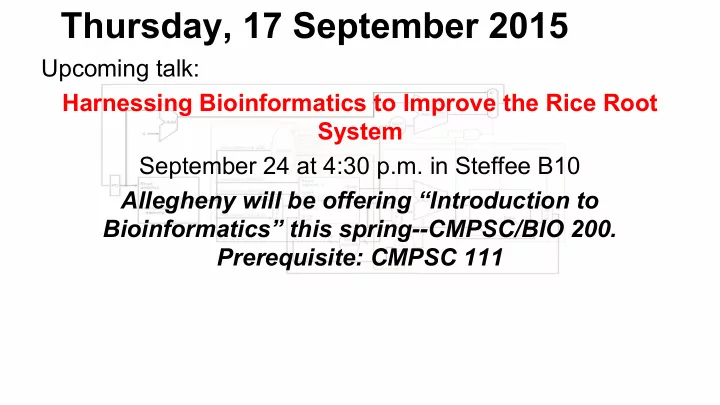

Thursday, 17 September 2015 Upcoming talk: Harnessing Bioinformatics to Improve the Rice Root System September 24 at 4:30 p.m. in Steffee B10 Allegheny will be offering “Introduction to Bioinformatics” this spring--CMPSC/BIO 200. Prerequisite: CMPSC 111
Today: ● Return lab 1 -- remarks ● Quiz! (Yay!) ● More on binary and twos complement ● Back to MIPS
Binary (unsigned) Base 2 -- each position from right to left is a power of 2, starting with 2 0 = 1: 1001011 1x2 6 + 1x2 3 + 1x2 1 + 1x2 0 = 64 + 8 + 2 + 1 = 75
Useful to Know: In k bits (unsigned), we can store all the values from 0 through 2 k -1. Example: 4 bits: 0 = 0000, 1 = 0001, 2 = 0010, …, 15 = 1111 (15 = 2 4 -1) Binary numbers ending in 0 represent even numbers; binary numbers ending in 00 represent multiples of 4; binary numbers ending in 000 represent multiples of 8; etc.
Converting Between Bases Converting from binary to decimal: add up powers of 2. (C example: “ bintodec.c ” in code repository). Converting from decimal to binary: repeatedly divide by 2 and look at remainders. Example : convert 13 to base 2 13 / 2 = 6, remainder 1 6 / 2 = 3, remainder 0 3 / 2 = 1, remainder 1 1 / 2 = 0, remainder 1 1101
Converting from Decimal to Binary Doing this in C is a bit tricky -- bits are computed from right to left, but we can’t print from right to left! Solution: use an array! See “ dectobin.c ” in repository.
Signed Integers Use the “twos complement” representation. Most significant (leftmost) bit is used to represent a NEGATIVE power of 2: Example (7-bit twos complement): 1001011 -1x2 6 + 1x2 3 + 1x2 1 + 1x2 0 = -64 + 8 + 2 + 1 = -53
Signed Integers In twos complement, a string of all 1s represents -1: Example (5-bit twos complement): 11111 = -32 + 16 + 8 + 4 + 2 + 1 = -1 It is actually easy to compute the twos complement representation of a negative number. First, find the binary representation of the absolute value, then flip all the bits and add 1...
Signed Integers What is -75 in 8-bit twos complement? +75 = 01001011 (Note: you have to fill in all 8 bits!) Flip: 10110100 Add 1: +1 10110101 = -75 The reverse process takes us back to +75: Flip: 01001010 Add 1: 1 01001011 = +75
Supplement to 17 September slides 1 1 0 1 0 1 0 1 1 0 0 1 1 1 1 1 Binary Addition (unsigned): 1 0 213 11010101 1 0 “Carries” + 159 + 10011111 1 1 1 0 372 101110100 1 1 1 1 1 0
Supplement to 17 September slides 1 0 1 1 0 0 0 1 Binary Addition (signed): 0 1 1 0 0 0 0 1 1 0 (8-bit 2s complement) 1 “Carries” -79 10110001 0 + 97 + 01100001 0 1 18 00010010 1 0 1 0 1 0 1
Representing Instructions the Computer §2.5 Representing Instructions in ■ Instructions are encoded in binary ■ Called machine code ■ MIPS instructions ■ Encoded as 32-bit instruction words ■ Small number of formats encoding operation code (opcode), register numbers, … ■ Regularity! ■ Register numbers $t0 – $t7 are reg’s 8 – 15 ■ ■ $t8 – $t9 are reg’s 24 – 25 ■ $s0 – $s7 are reg’s 16 – 23 Chapter 2 — Instructions: Language of the Computer — 12
MIPS R-format Instructions op rs rt rd shamt funct 6 bits 5 bits 5 bits 5 bits 5 bits 6 bits ■ Instruction fields ■ op: operation code (opcode) ■ rs: first source register number ■ rt: second source register number ■ rd: destination register number ■ shamt: shift amount (00000 for now) ■ funct: function code (extends opcode) Chapter 2 — Instructions: Language of the Computer — 13
Recommend
More recommend